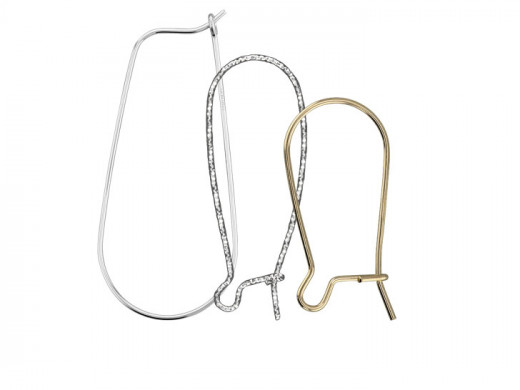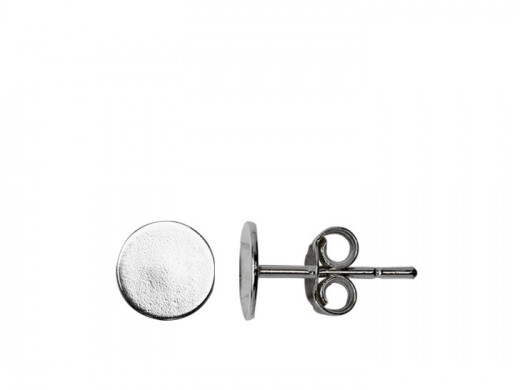How to Buy and Use Earring Findings in Jewelry Making
How to Buy and Use Earring Findings

Earring Findings
Earrings have been worn for thousands of years and therefore are a staple in the jewelry industry. This isn't a fleeting trend that will disappear, however, they have grown and evolved over time and can be quite confusing for new jewelers. In this article, I'll break down all of the different findings, as well as give you some important design elements to think about before your next purchase.
Purchasing
Designing
First, get a general idea of what you’d like to make. Are you hanging a drop or stone from the earring? Will it need to include a ring so that you can hang a bead or charm from it? Do you need the ring to be open or is a closed ring okay? How low would you like your earrings to hang after all of the components are assembled? Ear threads can be as long as 6 inches, ear cuffs sit in the middle of your ear, and posts snuggle against the piercing. These can all dramatically change the overall length of your piece.
When starting your own jewelry business, following the latest trends can be a valuable resource, especially if you're building a jewelry collection. Award shows, magazine photos, and articles specific to trends are all valuable tools to assist you as you grow.
Materials
What material would you like to work with? Silver or gold? Would you like sterling silver or fine silver? Gold-filled or solid gold? The prices between materials are vast, so have a general idea of your budget.
Note: I don’t suggest purchasing copper earring findings; a vast majority of people are allergic to it.
After deciding on the material, turn to your sketch or the mental image of your jewelry piece. Earwires are the most popular choice when it comes to findings. They hang about a ½ inch down below the earlobe; they look fantastic with beads, tassels and charms dangling from them plus they are a good choice if you intend to sell your work at shows or online because they are common among all of the age groups. This is an important factor. If you choose unconventional earring findings, they tend to be for a more targeted age group, which can make selling your work harder.
Purchasing
Now that you have an idea of the material and the design, head to your local jewelry shop or online store. Chances are you will have a lot of choices in front of you. This is the part that can be overwhelming, which is why it’s always a good idea to know what you’d like to make ahead of time. When placing your first order with a jewelry supply company, the most important thing you need to see are the UOM’s (units of measure). These can range between stores. Some stores sell by the piece which is literally 1 earring, so you would need to purchase two to create a pair. Others may sell by the pack so say, for instance, you buy one pack of 10 pieces, which equals 5 pair of earrings, not 10. So always be aware of the units of measure.
Now that you’re aware of designs, materials and UOM’s, let’s check out popular earring styles. These will help you design your piece, before purchasing the components.
Glossary
Earwires
From classic earwires to fancy ones, these are a popular choice when designing your earrings. The pros to choosing earwires are that they have been around for decades, they are liked across all age groups, and they are versatile. The cons would be that the classic earwires tend to push forward out of the earlobe if they are worn with scarves, turtlenecks or certain hairstyles. Fortunately, this is an easy fix. There are rubber backed stoppers that can keep the earrings securely in place while at the same time, remain out of view or you can choose kidney earwires.

Classic or French
This group of earwires is the most popular. Classic earwires are simple, inexpensive and practical. These are also known as shepherd hooks. The majority of them include a ring so that you can hang beads or other components from them.

Fancy
These are a fancier version of the classic earwires, shown above. They feature fancy ornaments and unique shapes but still have the wire hook in the back that is so beloved.

Kidney Shaped
Kidney earwires are a variation of the earwires shown above. These are also inexpensive, but they feature a hook on the back that latches the earwire shut.

V-wires or Marquise
Here is another variation on the classic, fancy and kidney earwires. V-wires tend to be larger than the two styles found above, so they can typically handle heavier components hanging from them. The heavier weight keeps them from pushing out of the earlobe like the lighter earwires occasionally do.
Hinge-backed
Hinge-backed earrings are premium earrings. They feature a hinge on the back, which snaps into place when closed. These styles of earrings will not slip out of the ear either, so you have peace of mind when wearing them or adding this style to your jewelry line.

Leverbacks
Leverbacks are quality hinge backed earrings. They open and close using a hinge located on the back of the earring. When in the closed position, they are securely snapped into place.

Clipback
Clip-ons allow people to wear the earrings without having a pierced earlobe. Watch the weight when dangling items from clipback earrings, though. They will slip down or fall off if the earring is too heavy.
Hoops
Hoop earrings are a definite favorite. They can range from lightweight, wire made hoops to thick, fancy tubular ones. Some you can string charms and beads on and some are ready-to-wear, as is.

Wire
These affordable, lightweight earrings can have charms strung on them or try wire wrapping beads on them. They’re fun to experiment with! To close wire hoops they either slide through a ring on the top or latch on a ring that has a bent end at the top.

Endless
Endless hoops have bodies that are made using hollow tubes. The wire at the top threads through the earlobe and then is inserted into the hollow tube, thus the name endless hoops.

Hinged
Made from hollow tubes or thick gauged wire, these hinged hoops are often ornate and ready to wear. At the top is a hinged wire which swings down and locks into a v-shaped slot which is a very secure closure.
Posts
With post styles, the earring post goes straight through the pierced hole. Because of this, they appear to be floating in the middle of the earlobe. They can range from simple ball studs to fancy ear climbers. After you place them through the piercing, they are held there using a clutch. Some posts are notched which hold the clutches more securely than posts without notches at the ends.
Note: You need clutches with post earrings, so make note if they are included or not. You may need to purchase them separately.

Posts or Studs
Simple or fancy, posts are popular findings among earring styles.

Pad Posts
Pad posts are flat and to use these posts requires soldering and bezel setting techniques. Using bezel wire or a tube bezel, solder that onto the front of the pad post, after you are done with the finishing steps, set an appropriate stone into the setting you have created.

Bezel Setting Posts
Bezel setting posts do not require soldering such as the pad posts do above, however, you do need stone setting skills. You need to know the inner dimensions of the bezel setting and then measure the stone for an exact fit.
Miscellaneous
This is a mixture of unconventional earring findings. Get creative with these fun and fancy earrings!

Ear Climbers
Ear climbers were fashionable I believe back in the 70’s, but for the last couple of years they have made a strong comeback. While most earrings hang below the earlobe, these styles actually climb up it. They are threaded through the earlobe with either a post or earwire style of earring.

Jackets
Earring jackets are a fun accessory. They can really add a lot to your earring creations. They hang from a post and you can place them either in front or behind the earlobe.

Chandeliers
Chandeliers have been around for a very long time. They hang from either posts or earwires and from there you can add drops, beads or charms to finish the piece.

Ear Threads
Ear threads literally thread through the piercing in your earlobe and hang down. They come in various lengths with some that are long, sweeping the shoulder area. Many of them come with rings so that you can add a small accessory to it.

Screwback
Similar to the hinged clipback earring, the screwback earrings also don’t need a pierced earlobe in order to wear. Use the screw to attach it to the earlobe.

Cuffs
A piercing is not needed with an ear cuff. This style of earring actually folds around the upper part of the ear. You can hang a long pendant or charm from them if a ring soldered on. They are very stylish!








